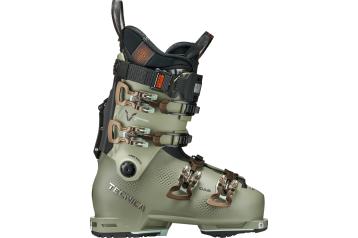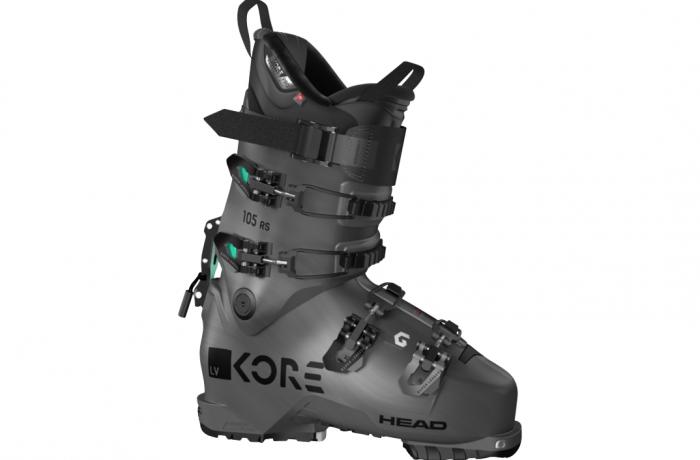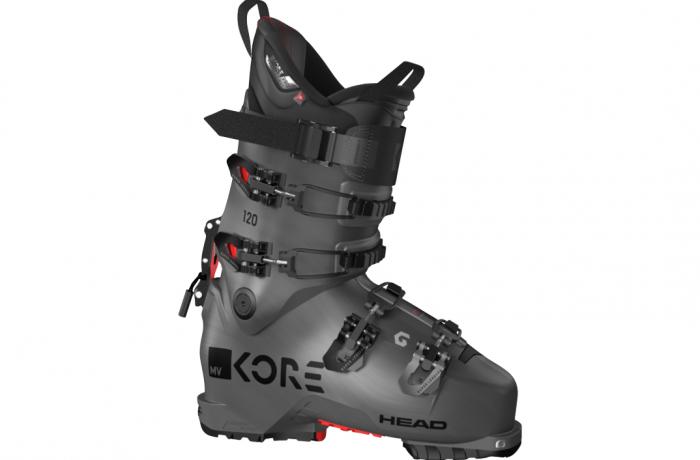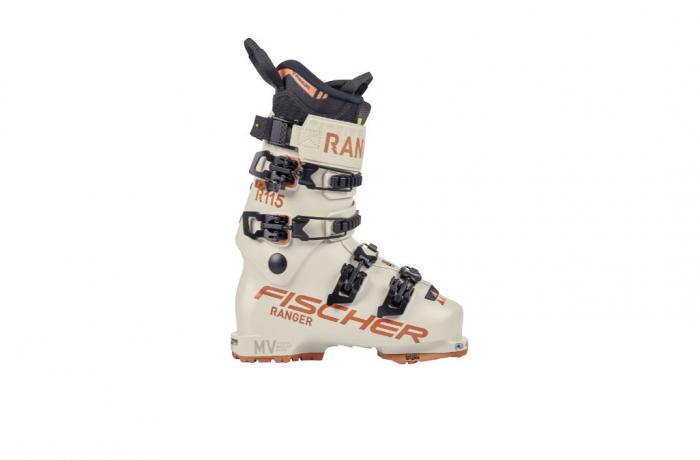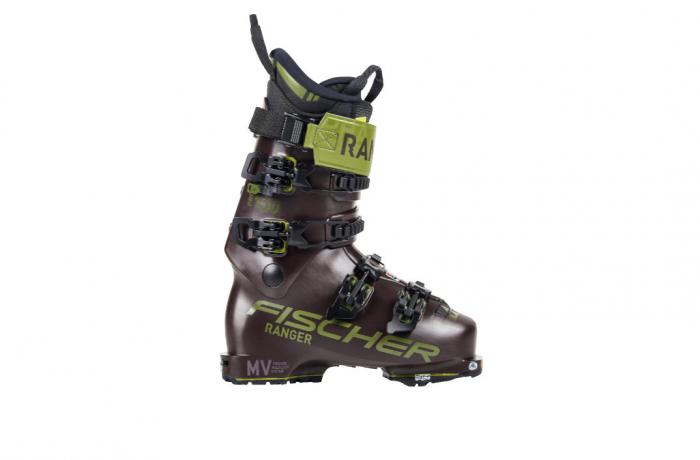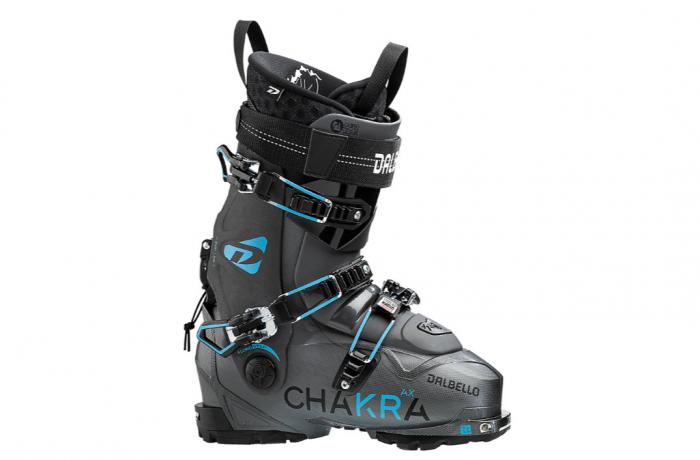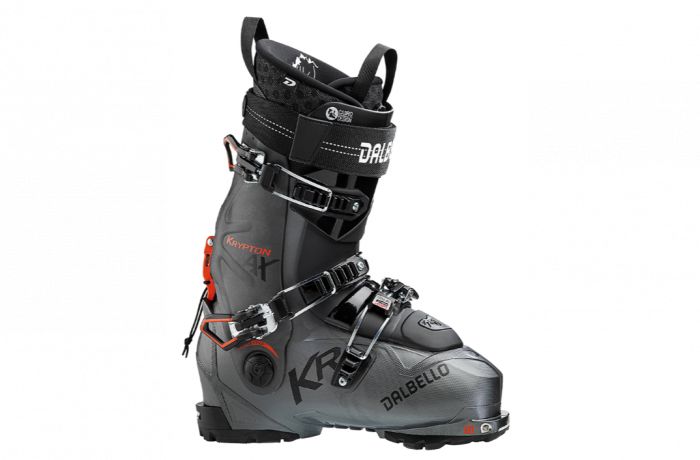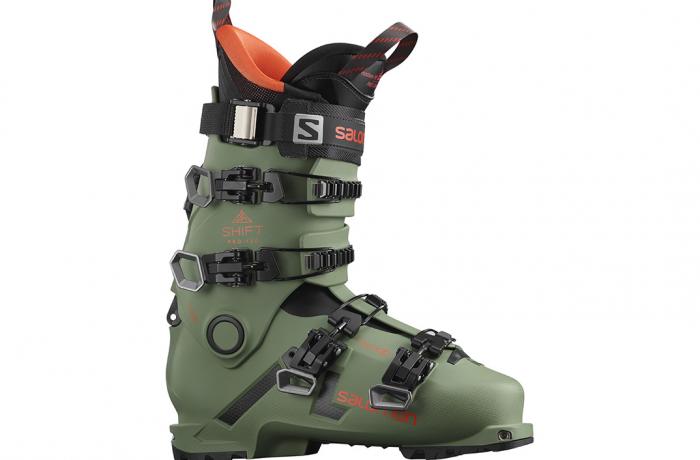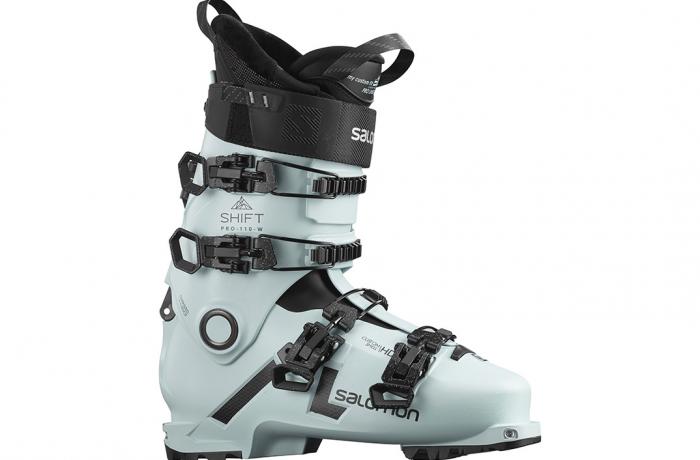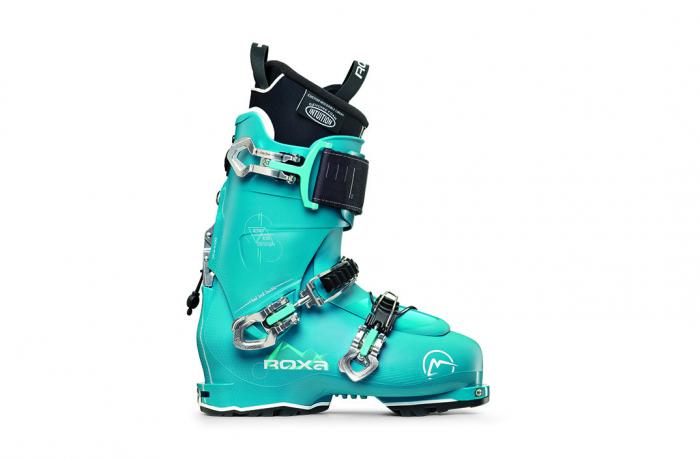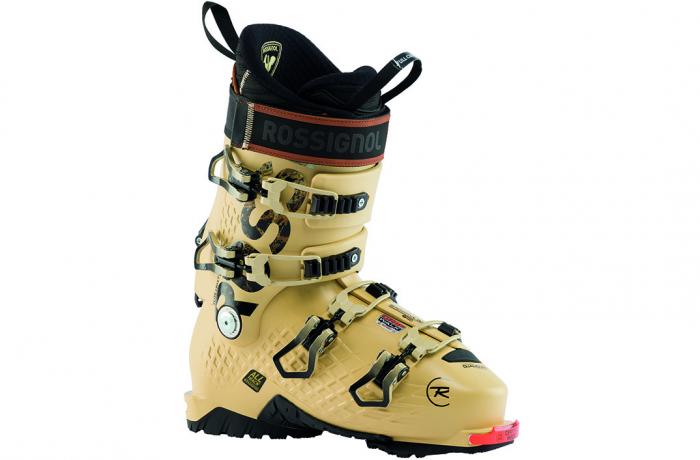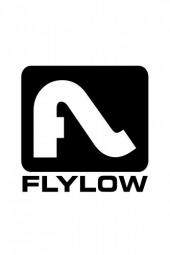All-Mountain Freeride
K2 Diverge W
K2 Diverge SC
Head Kore RS 105 W GW
The Freeride category remains a bit of a mixed bag, with a variety of different shell designs, plastics types, liner options and hike mode mechanisms to choose from. The defining characteristics of the category, tech fittings and a hike mode, may gain a model entry into the marketplace but they certainly don't guarantee that a boot will deliver on the three most important criteria: fits well, skis down well, goes up well. Our women's test team is a demanding bunch who won't take any trade-offs in fit or skiing performance for the sake of uphill capability, so when they say the Head Kore RS 105 W GW ticks all three boxes without issue we call that a gold medal level seal of approval.
The new Kore for the women's and men's lines is revised this year to employ the lower shell shape of the narrow Formula RS and medium Formula all-mountain boots. This change and the use of a polyurethane lower shell has proven to be a game changer for the model according to our testers. The new Kore 105 W GW fits as well as its narrow all-mountain sister, skis as well as it does, and manages both of those feats while shaving weight with a polypropylene (Superlight) upper cuff construction and incorporating an updated hike mode lever that testers loved. They said the range of motion when released is smooth in quality and adequate in range and in concert with GripWalk soles and tech fittings manages to slot the Kore into the very top of women's freeride boots available today.
Testers mentioned that the cuff height felt slightly lower than average on the leg shaft (they had similar feedback about the Formula boots) which was great for some and less-than-ideal for others, but they said the 105 flex rating was true and the flex feel was even and well distributed against the leg. Stance angles are neutral in all directions according to testers who said that they varied radius and speed through a mix of terrain and snow with good response. In fact, the Kore RS 105 received perfect scores for Dynamic Balance and Edge Power as proof there.
The superleggera (Italian for super light) buckles were indeed minimal but also functional and testers like the fat 53 mm ratchet cam powerstrap. The double pull loop liner is always appreciated and the Form Fit shell molding feature is a slick way to open up the fit slightly or provide a moderate stance angle improvement. The Liquid Fit liner option is there for filling the heel pocket for the ultra-skinny-foot folks out there.
Head Kore 120 GW
The all-new Kore freeride boot may have caused some problems at home--it essentially ditched its Nexo family roots, went down the hall and cozied up to cousins Raptor WCR and Formula who bestowed upon it their many positive traits while allowing it to maintain a hike mode (nicely revised this year as well), its Kore-ish tech compatibility and lightweight cuff construction. The Kore 120 GW impressed our test team with its re-imagined form which took it from an okay performer in the category last year to the category winner this time around.
The Kore 120 is now a medium width Formula with lighter weight cuff plastic, a hike mode and tech fittings, plus an all new liner with articulation for better cuff rotation when released for touring. It all actually works, our test team agreed, and works quite well. They said it's one of those freeride unicorns--the kind that fit and ski as well as the very best all-mountain boots yet manage to offer a releasable cuff for skin track forays or rambling ridge top routes. Where the Kore of old had some flex feel and shin fit issues, the new Kore 120 GW has thankfully banished those and instead offers a solid and progressive feel against the leg while skiing and a smooth glide forward and back when ascending.
Testers praised the Kore's neutral lateral stance angles (a good thing, sans cuff adjustment mechanisms) and they also liked the out-of-box fore-aft stance. The fat 53 mm "Ratchet Velcro" power strap was a test favorite, and testers mentioned that even entry and exit was improved with this new Kore design. Testers liked the lightweight and easily managed buckles and found that the cuff release was simple and easily operated.
As evidenced by the tester comments tab here--not a caveat in sight.
Fischer Ranger 115 GW DYN WS
The 99 mm Ranger women's freeride line has always been a hit with our test team and this time around was no different. The in-between narrow and medium fit characteristics continue to suit the skier with a lower volume foot and leg who's looking for just a touch more room in a warm, all-day-long boot solution for crossover on-area and skin-required missions. Fischer's 99 mm Ranger pairs with its roomier sibling 101 mm Ranger One to cover the majority of foot and leg shapes looking for performance freeride features.
Testers liked that while the boot remains lightweight, traditional polyurethane is used in both the shell and cuff for stability and reliable edge-driving power which they say is on board without fail in all conditions tested. The boot is somewhat tall on the leg and the cuff is upright in its stance set-up, so while testers liked the progressive flex feel, the geometry plus legit 115 flex level make this a sturdy beast that needs a real skier on board for proper handling on the descent. They also liked the 115's closure cinching power offered by the cam lock style power strap (it morphs to a 35 mm Velcro job on the 105 flex model) but mentioned that the tall and stiff set-up reduced a little bit of quickness (at least for the lighter weight testers) and suggested that the softer model might offer a more supple and quicker feeling set-up for skiers looking for agility over aggro downhill power.
The ultra-stealthy hike mode flip lever remains a test team favorite, and veteran testers are always amused at new testers' confusion when they can't find the actuator (it's a tiny little bugger hiding under the top cuff buckle) that controls the internal cable release. Testers maintain that the range of motion in touring mode is one of the best out there, regardless of category, and the quality of movement is both smooth in rotation and consistent in fit--this fact alone sets the Ranger boots above most others in the All-Mountain Freeride group, especially if a skier is planning to don skins.
Fischer Ranger Pro 130 GW Dyn
The revised Ranger Pro 130 GW Dyn returned to the boot test and impressed our test team with a highly cushioned, warm and comfortable version of its all-mountain hybrid self. Testers loved the smooth entry and the Ranger Performance Liner's soft contact against the foot and leg. The internal cable hike mode release switch remains a test team favorite for its stealthy, sneaky design (it hides beneath the top cuff buckle) but testers like even more the long and smooth cuff range of motion that it allows, combining with tech compatibility and relatively light weight to produce one of the best freeride boots that actually might put a few miles together in a skin track.
Testers found that the 99 mm fit was a little bloated in places, namely over the top of the toes and forefoot and through the instep. This extra amount of vertical space, or ceiling height, offered a dreamy fit for our high arch and high instep testers who got in and buckled without crushing the top of their foot. The combination of snug heel and ankle with a spacious instep fit is a rare one in the narrowish lasts, and testers mentioned that skiers fitting that bill should keep this high on their short list. Our lower volume testers found that the uncharacteristic instep room reduced the boot's heel retention and they mentioned some movement back and forth inside the boot during fore and aft movements.
The Ranger Pro 130 GW Dyn is deceptively strong in side to side movements, testers agreed, noting that edge engagement was predictable, strong and quick. They also agreed that the flex felt a little softer than billed at 130, and several mentioned that while the boot came without the rear spoiler installed, they preferred it in to slightly tip the stance more forward and take up the extra space in the cuff. This was for our slender to average leg shape folks--the thicker the calf and leg, the more perfect the Ranger Pro was in its stock set-up.
As with all things slightly outside the box, the Ranger Pro 130's plum color way ignited some passions--some hated it, while the majority of testers said it was cool. They all like the fat Phatt Max power strap for its, well, fatness, and for its cam buckle lock on the leg. GripWalk soles combine with the boot's light-enough weight, long touring stride and tech compatibility to keep this one at the top of the heap for true uphill mobility in the form of a proper descender.
Dalbello Chakra AX T.I.
Much like the Dalbello Chakra AX's many layers of liner, shell, cuff and buckle overlaps, testers found many layers of elements and features to peel back, discover and unlock its all-mountain and hike-to capabilities. Also like getting the Chakra AX on the foot and buckled up, testers took their time in getting to know this boot and its ins and outs.
The medium width fit with a particularly comfortable yet snug hold on the heel and ankles was the first hit for testers, who liked the anatomical shape that suited the average foot, leg and calf quite well. They cited a bit of extra room over the top of the foot and through the instep, which they appreciated for skiers with a thick or bony fit issue there--in conjunction with the open throat cabrio lower this offered a potentially good solution for the blood flow and cold foot challenged, testers mentioned. Testers liked the tall and upright cuff, which helped balance out the slightly soft flex at 95, creating a good starting point for a centered stance and a little extra room for a thicker calf. They also liked the cushioned liner feel against the foot and leg, citing that it was one of the most comfortable fits of the category.
Testers found no surprises during on-snow descent tests--they loved the smooth entry into turns and stable control the Chakra provided through each arc, regardless of speed or snow surface. They commented that balance and power were more than adequate for the category but gave the boot higher quickness scores for its lightweight package and accurate guidance of the ski in tight spots and tighter radius turns.
The test team wasn't blown away by the touring range of motion or ease of use of the walk mode switch but neither did they have any real problems with it. The Chakra struck our testers as a more area-based adventurer that would handle short forays off the beaten path before returning for another chair ride to send a ripper to the bottom. They liked that the cuff was a lighter weight material, but they liked more that the lower shell was traditional, stable polyurethane. They liked the addition of GripWalk soles to this year's version of the AX and they said the simple 40mm Velcro power strap worked just fine.
Dalbello Krypton AX T.I.
While testers were a little confused about where the new Krypton AX T.I. sat in Dalbello's line (more like a Lupo AX than a Krypton, testers mused) they liked it all the same! Essentially, Dalbello took a good boot and made it better by adding GripWalk soles and a hike mode--and really, testers had no issue with any hike mode related performance deficit. So, chalk up this new iteration of a boot we've seen glimmers of in the past as a win!
Testers unanimously commented on the boot's comfort factor, which was high in all respects and fit zones. Part of the comfort was due to the soft-against-the-foot liner construction and part was due to extra room over the top of the foot, from toebox all the way through the instep. This offered a lot of bloodflow and zero nerve impingement on the top of the foot, but testers mentioned that the compliant liner and extra vertical space made for some fore-aft slippin' and slidin' around inside the shell. Testers takeaway wasn't bad, but pointed toward the thicker foot and instep as the perfect match for the ample overhead storage available here. Testers were also in agreement that the stance set-up was on the upright side of things, which worked great for longer legged and thicker calf testers but some of our shorter guys and chicken-legged struggled to move the cuff into a slightly more forward attitude.
The Krypton AX T.I. handled itself well in all conditions, transferring accurate movements to ski on hard and soft surfaces alike and it was not bothered by chaotic crud--though it was a dream to ski in smooth, untracked pow, testers said. While some testers felt lacking in overall connection around their feet, many mentioned that the heel pocket controlled the rearfoot well for maintaining some crisp control over things regardless of the pillow fight going on up in the forward cabin.
Closure was classic Dalbello cabrio, and as such some testers complained about the various straps and overlaps, but all agreed that the containment offered by three buckles and its 40mm power strap was adequate and would be even better with some added foot and instep flesh. Testers noted that the hike mode switch was easy to deal with and the range of motion rearward was good, while the forward range was a bit limited, reminding that the Lupo AX's fully removable tongue offers increased touring range of movement for skiers looking for a little more off from an on-off-area boot than they might find here with the more descent-centric Krypton AX.
Salomon Shift Pro 130 AT
The Gist
Our test team's long wait for a successor to the QST line has come to a welcome end with the arrival of the new Shift Pro family--with a bootified take on the exceedingly popular Shift binding, the Shift Pro 130 AT sits at the top of the heap as a legit Freeride assault vehicle. Built off the tester-favored S/Pro medium width lower shell, the Shift Pro returns to a lightweight four-buckle overlap platform and combines a polyamide lower shell and Xecarb (carbon and glass hybrid) composite Coreframe insert with a polyolefin cuff to create a crisp, transmissive boot. Testers said it's just padded enough by its pre-shaped and seamless liner to be comfy without bulk.
The Fit
Testers say that the list of fit improvements over the QST is long--a more true medium width fit overall is the takeaway, with a broader fit along the lateral side of the foot and a taller fit through the instep, which along with more compliant material there made for much better entry and exit. The Shift Pro is light on the foot, thanks to thin shell wall construction with polyamide and polyolefin plastics. The flex feel is firm against the shin but progressive, testers report, and they liked the overall fit when the cuff was released as well. The fit over the top of the foot is even and open enough for good circulation by way of the My Custom Fit 3D seamless liner.
Performance
The testers who were able to get the Shift Pro 130 on snow this year said that the lower boot feel is damp and stable, a la the S/Pro medium width alpine boot it's modeled after and the cuff's snappy flex feel made for agile transitions turn to turn without feeling jittery.
Cool Features
The Surelock cuff release mechanism remains a tester favorite and the touring range of motion it enables in addition to the rolling stride of GripWalk soles and light weight make this a real contender for more extended off-area missions. Testers like the 45mm Sense Claw cam buckle power strap on the 130--Velcro power straps are found on the other Shift Pro boots in the line.
Salomon Shift Pro 110 W AT
The Gist
Testers love Salomon's shift to a four buckle overlap design in the new Shift Pro 110 W AT freerider. They liked the new, easy slide on and off and particularly got on board the newfound room over the instep and along the lateral side of the forefoot, a la the S/Pro lower mold that it's based off. Testers approve of the stability and snap of the polyurethane and fiberglass Coreframe lower paired with a light and reactive polyolefin cuff which fits closely along the lower leg and is still rigidly connected to the lower with the tried and true Surelock cuff release mechanism.
The Fit
Testers say that the list of fit improvements over its predecessor QST is long--now a more true medium width fit overall, testers say, with a broad fit along the lateral side of the foot and a taller fit through the instep, which along with more compliant material there made for much better entry and exit. The Shift Pro Ws are light on the foot, thanks to thin shell wall construction with polyurethane and polyolefin plastics. The flex feel is firm against the shin but progressive, testers report, and they liked the overall fit when the cuff was released as well. The fit over the top of the foot is even and open enough for good circulation by way of the My Custom Fit 3D seamless liner.
Performance
The testers who were able to get the Shift Pro 110 W on snow this year said that the lower boot feel is damp and stable, by way of the S/Pro medium width alpine boot it's modeled after and that the cuff's snappy flex feel made for agile transitions turn to turn without feeling jittery.
Cool Features
The Surelock cuff release mechanism remains a tester favorite and the touring range of motion it enables in addition to the rolling stride of GripWalk soles and light weight make this a real contender for more extended off-area missions. Testers like the simple 45mm Velcro power strap on the 110 W.
Roxa R3W 105 TI I.R.
The Gist
The R3W 105 TI I.R. enters the fray for next year with an updated graphic and a tongue-style Intuition-Roxa full thermo liner to remain our test team’s favorite three-piece freeride boot. It's a svelte 99 mm three-piece (cabrio), contouring closely along the curves of the foot and lower leg and minimally padded by the custom liner to maintain a direct, connected feel with the ski. The Grilamid shell and Polyurethane cuff combine for a unique blend of light weight and strong flex feel. The hike mode's range of travel is impressive and GripWalk soles add to its easy rolling stride, testers said.
The Fit
Testers say this 99 mm rides the fit fence between the medium width and narrow groups. The toebox is snug, and the shell feels very close to the navicular and ankle bones—most testers had a full liner molding on their to-do lists. The heel pocket is a bit tight, they say, but right. The calf offers a bit of relief from the squeeze, so average legs attached to slender feet will do well here. Testers noted a sharp feeling tongue against the shin, and again were hopeful that cooking and molding the tongue-style I.R. liner would put that to bed.
Performance
Uncharacteristic of most three-piece boots, testers said the flex feel is stout (stiffer than the 105 labeling) and because it starts from an upright position it required some push to find a fore-aft sweet spot. Testers liked the power that the solid cuff generated in lateral moves and said it tipped all manner of skis onto edge and held them there well. The boot's performance sweet spot is in the lateral moves, testers agreed, allowing the stiff, thin-shell-walled lower boot to feel the snow surface and sink its teeth in. Transitions between turns were lively and quick and edging response was immediate, testers said.
Cool Features
Testers like the collection of gadgetry here. The power strap buckle is wide and easily dialed in for tension. The 45-degree second buckle retains the foot at the instep effectively. The ski-hike cuff lock is simple to actuate, and in conjunction with a long and friction-free range of travel in hike mode, they liked the easy roll of the GripWalk soles when walking. Note that the R3W 105 TI I.R. is tech compatible, and that if a skier plans to use them with alpine bindings, be sure those are GripWalk compatible--a set of alpine DIN soles does come in the box.
Rossignol Alltrack Elite 130 LT GW
The Gist
The Dual Core Grilamid shell Alltrack Elite 130 LT was the highest scoring narrow hike mode boot and the third-highest scoring hike mode boot, regardless of width, the last time we tested it. So, it's good. And it's back again unchanged except for a new, sandy cosmetic. How was it so good? Testers liked that it shaved the weight without losing its boot-ness. It still fits and skis like a Rossi (meaning anatomically contoured, strong and quick) just a lightweight one, they said. The Dual Core polyolefin HD cuff is light but snappy, testers said, claiming it remains tall and strong against the leg for solid charging through variable, manky piles on big, fat skis to punch well above its weight class.
The Fit
Testers said the fit was best described as a roomy narrow in the toebox and forefoot and a narrow the way they expect a narrow to fit from there on back, with a little extra shape at the top of the cuff to contour around the calf muscle. The Alltrack Elite 130 LT's score for Anatomical Fit & Initial Feel was the highest in the entire On-Off Area group. Testers noticed a rapid break-in of the liner to the foot upon skiing and the tightest spots relaxed just enough to forego immediate calls for a bootfitter. Easy on and off with neutral stance angles was the call, with some testers noting a slightly more upright fore-aft position without the spoiler installed (it comes loose, in the box) and others citing a slightly more forward position with it in—so we guess that's about where it should be, then. As with other Rossignol boots, testers found the length fit generous--which isn't a bad thing for a boot with hiking and touring intentions.
Performance
Testers issued zero demerits for the use of Grilamid in the shell and cuff—there were no comments about a lack of power, stability or dampness. There were, however, comments about quickness edge to edge and rapid reaction to foot steering movements. The lighter weight of the boot (1660 grams) was very apparent to testers, who approved once they got confirmation that it could ski. A couple testers thought the lateral stance angles were a touch under-edged making for a steery schmeary ride until the skis were rolled up a little steeper, where the power became evident, but the majority felt the edge power was on tap from the get-go. Testers agreed that the LT cuff's touring range of motion is much improved over the other Alltracks, but still not as good as a few others in the category.
Cool Features
Dual Core plastic injection is a shared technology with Lange. Testers appreciated the performance and fit enhancements that derive from this new process at last year's test when the Dual Core Lange's blew their own predecessors out of the water. We don't have the benefit of non Dual Core Grilamid Alltracks to try in head-to-head tests, but our test team is confident that Dual Core is for real, and now it's available in light, stiff Grilamid as well. Bravo Rossignol. Testers like the simple and straightforward features kit: power strap, upper cuff adjustment, Velcro spoiler, Grip Walk soles (separately), Dynafit certified tech fittings, four light weight buckles.
